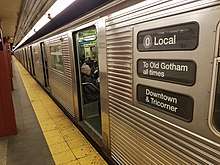R32 (New York City Subway car)
The R32 is a New York City Subway car model built by the Budd Company from 1964 to 1965 for the IND/BMT B Division. A total of 600 R32s were built, numbered 3350–3949, though some cars were re-numbered. The R32 contract was divided into two subcontracts of 300 cars each: R32 (cars 3350–3649) and R32A (cars 3650–3949); the former was paid by the city's capital budget and the latter was paid through a revenue bond. All are arranged as married pairs. The R32s were the first mass-produced stainless steel cars built for the New York City Subway.
| R32 | |
|---|---|
An R32 train on the J at Lorimer Street | |
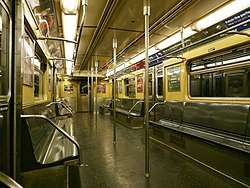 Interior of an R32 car | |
| In service | 1964–present |
| Manufacturer | Budd Company |
| Built at | Philadelphia |
| Replaced |
|
| Constructed | 1964–1965 |
| Entered service | September 14, 1964 |
| Refurbished | 1988–1990 |
| Scrapped |
|
| Number built | 600 |
| Number in service | 136 (10 additional cars in work service) |
| Number preserved | 8 |
| Number scrapped | 360 |
| Formation | Married Pairs |
| Fleet numbers | 3350–3949 (3659 renumbered to 3348) |
| Capacity | 50 (seated) |
| Operator(s) | New York City Subway |
| Service(s) assigned | |
| Specifications | |
| Car body construction | Stainless steel |
| Train length |
|
| Car length | over coupler faces: 60 ft 3 in (18.36 m) |
| Width | 10 ft (3,048 mm) |
| Height | 12.08 ft (3,682 mm) |
| Platform height | 3.76 ft (1.15 m) |
| Entry | 3.76 ft (1.15 m) |
| Doors | 8 sets of 45-inch (1,143 mm) wide side doors per car |
| Maximum speed | 55 mph (89 km/h) |
| Weight | 79,930 lb (36,260 kg) (post-rebuild) (70,000 lb or 31,751 kg when delivered) |
| Traction system | General Electric SCM 17KG192E3, DC propulsion system |
| Traction motors | GE 1257E1 motors or Westinghouse 1447JR (115 hp or 86 kW per axle) (R32GE cars used 115 hp or 86 kW 1257F motors, all cars originally had Westinghouse 1447JR motors) |
| Acceleration | 2.5 mph/s (4.0 km/(h⋅s)) |
| Deceleration |
|
| Electric system(s) | 600 V DC Third rail |
| Current collection method | Contact shoe |
| Braking system(s) | WABCO RT2 SMEE braking system, A.S.F. simplex unit cylinder clasp (tread) brake |
| Safety system(s) | tripcock |
| Coupling system | Westinghouse H2C |
| Headlight type | halogen light bulb |
| Track gauge | 4 ft 8 1⁄2 in (1,435 mm) standard gauge |
A ceremonial introduction trip for the new R32 "Brightliners" cars was held on September 9, 1964. Various modifications were made over the years to the R32 fleet. In the late 1980s, all of the R32 cars were rebuilt, with ten cars being rebuilt by General Electric and the remaining cars being rebuilt by Morrison Knudsen. As part of the refurbishment, the original rollsigns and express/local marker lights at the end of each car were replaced with flipdot signs. After refurbishment, the R32 and R32A cars were renamed R32 Phase I, R32 Phase II, and R32 GE. The R160s replaced most of the R32s in the late 2000s, though about one-third of the original fleet remained, all being Phase I R32s. The rest of the R32s were initially retired in early 2020 and replaced with the R179s;[1] however, they returned to service in summer 2020 due to the R179s being pulled from service.[2] Several retired cars were saved for various purposes throughout the New York City Subway system, with some used as work cars, and others preserved for the New York Transit Museum and Railway Preservation Corp.
Description
The R32s are numbered 3350–3949, although some cars were re-numbered outside of this range or to different numbers in this range. They were the first cars to introduce all-mylar route and destination rollsigns instead of the former cotton cloth or linen type rollsigns found on prior rail cars.
The R32 contract was divided into two subcontracts of 300 cars each: R32 (cars 3350–3649) and R32A (cars 3650–3949).[3] The R32As were funded through the proceeds of a revenue bond, while the R32s were paid for out of the 1963–1964 New York City capital budget. The two subcontracts differed with the first 150 R32s having visible bulkhead horns – the last cars to be built with this feature – on R32 cars 3350–3499.[4][5] This feature can be found on the Redbirds, R27s and R30s, along various older trains. Another distinctive difference was the interior lighting featuring backlit ad-signs; on R32A cars 3800–3949.[6][7]
The R32s were the first mass-produced stainless steel cars built for the New York City Subway. Two previous Budd orders (the BMT Zephyr and the R11s) were limited production and/or experimental orders. The horizontally ribbed, shiny, and unpainted stainless exteriors earned the cars the nickname Brightliners.[8] The use of stainless steel reduced the weight of each car by over 4,000 pounds, when compared to previous models.[9]
History
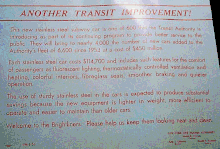
In June 1963, the New York City Transit Authority contracted with Budd for 600 IND/BMT cars (300 pairs) to replace older equipment (cars that had exceeded the TA's 35-year limit of age), including the BMT D-type Triplex articulated cars and some of the BMT Standards. At the time, this was the largest railcar order ever placed in the United States for subway cars. The cars were ordered for $68,820,000,[9] of which half was provided by New York City and half through the sale of bonds by the New York City Transit Authority.[8] Budd had bid on previous contracts with the NYCTA, but had never won a City contract for a production run of cars until the R32s, as Budd built only stainless-steel equipment and the TA refused to allow a differential in competitive bids for this higher-quality construction.[10]
Budd won the contract by offering the lowest bid of $114,700 per car. The next lowest bidder came in at $117,900 per car, which was for low-alloy steel cars. Budd low-balled the price to win the contract and introduce stainless steel equipment to the modern New York City Subway system, a plan that was met with limited success.[10] NYCTA allowed a premium for subsequent stainless steel contracts, and all subsequent equipment was at least partly constructed of stainless steel. However, the Budd Company never benefited from the change, as they failed to win further contracts from the NYCTA, and the company has since halted production of railroad cars.
The R32 cars originally came with blue passenger doors and blue storm doors. The passenger doors of many cars were repainted silver from 1974, as the graffiti epidemic worsened.[11] However, some cars retained or regained blue passenger doors towards the start of the General Overhaul (GOH) program, which replaced all the doors with stainless steel versions.[12]
On August 18, 1964, the NYCTA approved a modification to the 300 R32s already constructed. The modification was required to ensure proper clearance in tunnels. Since the cars were 4000 pounds lighter than other subway cars when new, they did not sink as low on standard trucks and springs. The modification involved the modification of the body bolster.[13]
A ceremonial introduction trip for the new R32 "Brightliners" cars was held on September 9, 1964, operating from the New York Central Railroad's Mott Haven Yards in the Bronx to Grand Central Terminal in Midtown Manhattan.[9] The new cars were then placed into service on the Q on September 14, 1964, after their New York Central's spring-loaded under-running third rail shoes were replaced with gravity-type overrunning subway third rail shoes.[8][9] The R32s were originally assigned to the BMT Southern Division service only, initially on the Brighton Line (Q train) and the Sea Beach Line (N train), but were eventually reassigned to the West End Line (T and TT trains).
Cars 3946–3949 were delivered with Pioneer trucks and disc brakes in 1966. These trucks were replaced with standard trucks in 1976.[14][15][16][17]
In 1974, cars 3700–3701 were sent to Garrett AiResearch's facilities in Los Angeles, California to test out Flywheel energy storage system equipment. 3700 received energy conservation machinery with batteries and amber-type digital readout indicating the amount of energy used by the equipment, while 3701 remained un-modified. These cars were later tested at the UMTA, and the US Department of Transportation's Testing Facilities in Pueblo, Colorado for evaluation, and were returned to the MTA in 1976 for in-service testing on all BMT/IND Lines to check the effectiveness of the technology.[18]
Overhaul and mishaps
Cars 3616, 3629, 3651, and 3766 were scrapped due to collision damage sustained in various accidents in the 1970s and 1980s. Their mates were paired with other cars.[3]
Car 3659 was rebuilt as an even-numbered car and renumbered to 3348 following the loss of its even-numbered mate in an accident. Car 3669 was retired following a derailment, so its even-numbered mate 3668 was rebuilt into an odd-numbered car and renumbered to 3669.
From 1988 to 1990, as part of the NYCTA General Overhaul (GOH) program, the R32 cars were rebuilt. Ten cars were rebuilt by General Electric at its facility in Buffalo, New York (cars 3594–3595, 3880–3881, 3892–3893, 3936–3937, and 3934–3935) as prototype rebuilds, and the remaining cars were rebuilt by Morrison–Knudsen at its facility in Hornell, New York.[19] During the rebuilding process, the route and destination mylar rollsigns located above the storm doors were removed and replaced with Luminator flipdot electronic route signs that can display both letters and numbers, including zero. This is because the air conditioning evaporators mounted on the interior car ends made it difficult to change the front route and destination signs. The distinctive "EXP" (express) and "LOCAL" marker lights were also removed.[20][21] The rollsigns on the sides of the cars were updated and retained.
After refurbishment, the R32 and R32A cars were renamed R32 Phase I, R32 Phase II, and R32 GE. The R32 Phase I cars (re-built by Morrison Knudsen) have WABCO Air Brake packages, GE Master Controllers, and Thermo King HVAC units. The R32 Phase II cars (also re-built by Morrison Knudsen) had NY Air Brake equipment, Westinghouse Master Controllers, and Stone Safety HVAC units. The ten prototype rebuild R32 GE cars differ from the Phase I and II cars as they were rebuilt to R38 specifications. They had experimental Sigma HVAC Units powered by A/C motors and solid state inverters, original traction motors rebuilt to 115 horsepower instead of the traditional 100 horsepower units, backlit ad signs, and different bulkhead designs.[22] Since the cars were sent out to be overhauled based on how poorly they were performing (worst first), there were R32s and R32As rebuilt in both Phase I and Phase II configurations. There were also about a dozen or more pairs which are composed of R32 and R32A mixes.[3]
Retirement
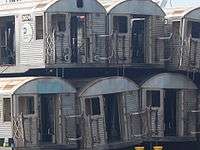
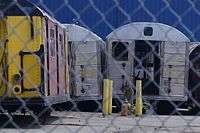
The R160s replaced most of the R32s in the late 2000s. The ten GE cars were retired first in the summer of 2007. The Phase II R32s followed a year later, from the summer of 2008 until October 13, 2008. Finally, a handful of Phase I R32s were retired from early 2009 until November 2009, when it was decided to retire the NYCT R44s instead. By October 2010, only 232 active cars remained, 222 of which[23] were assigned to 207th Street Yard, operating on the A and C. These had periodically underwent intermittent SMS (Scheduled Maintenance Service, a life-extension program) cycles - at a cost of $25 million - to extend their useful lives.[24][25]
The R179s are replacing the remainder of the R32s. The cars were originally slated for retirement in 2017,[26][27] but the R179s experienced delays in delivery. Subsequently, plans were changed to retain the R32s in order for them to provide a backup fleet and support service increased frequencies until in 2022, when they would finally be replaced by the R211s;[28][29][30] however, by January 2020, it was again decided to retire the R32s with the R179s.[31] With the R179 delivery completed, the R32s were gradually sidelined until the last train, consisting of pairs 3488–3489, 3514–3515, 3646–3647, and 3520–3891, made its final trip on the C on March 26, 2020.[3][1] However, in June 2020, some cars were reactivated and transferred to East New York Yard to provide backup revenue service due to the R179s being pulled from service because of link bar issues.[32] By July 1, 2020, the R32s re-entered service on the J/Z.
Most cars retired by the R160s were stripped and sunk as artificial reefs.[33] However, after the reefing program ended in April 2010, retired R32s have been trucked to Sims Metal Management's Newark facility to be scrapped and processed, an action that occurred between April 2013 and October 2013 with several already-retired cars and is expected to occur with the remaining cars.[34]
Some R32 cars were saved for various purposes throughout the New York City Subway system. The full list includes:
- Phase II pair 3350–3351 - set aside for preservation by the Railway Preservation Corp. This pair is currently stored at the Coney Island Yard.
- Phase II pair 3352–3353 - set aside for preservation by the New York Transit Museum. This pair was the lead pair on the R32s' premiere trip on September 9, 1964. The pair is currently stored at the 207th St Yard.
- GE-rebuilt pair 3594–3595 - being used as NYPD training cars at Floyd Bennett Field.
- Phase I pair 3786–3787 - being used as derailment re-railing training cars at the Coney Island Complex.
- 10 cars that were taken out of revenue service in 2010[3] - now used for work service; six of these cars are based from the 36th-38th Street Yard, while the other four are based from the 207th Street Yard. All cars handle such tasks as providing traction for B Division rail adhesion cars and refuse trains.[3]
Longevity
The remaining R32s still in service are over 55 years old, currently the longest such service life for an R-type subway car, and the second longest such service life in New York City rapid transit operations.[lower-alpha 1][35] They were the last cars built for the New York City Transit Authority - prior to its merger with the Metropolitan Transportation Authority in 1968 - to remain in service. The R32s had survived well past their specified service life of 35 years; they are the oldest rolling stock since the retirement of the Redbird trains,[9] and the oldest rolling stock of any metro system in North America, as well as some of the oldest rolling stock of any metro system anywhere in the world.[lower-alpha 2][37] The R32s also outlasted the newer R38s, R40s, R42s and New York City Transit R44s.[37] According to railfan James Greller, they are often cited for their superior durability and craftsmanship, along with the structural reinforcement done to their bodies during the GOH period.
Despite their considerable structural quality, the R32s suffered from low mechanical quality, especially near the end of their service lives. They had the lowest Mean Distance Between Failures figures of the active fleet, as the overhauls they received during the 1988–89 period have all worn out after 29–30 years.[38] Others criticized the R32s for their appearance and lack of comfort; in August 2011, The New York Times called the R32s "a dreary reminder to passengers of an earlier subterranean era", and claimed that "time has taken a toll" on the cars.[37] They had worn-out air conditioning, propulsion, and braking systems, so they were often temporarily transferred to services with mostly outdoor or elevated portions, namely the A, J, and Z.[39][40][41]
In popular culture
In the famous car chase scene in the film The French Connection, the chased train of R42s crashes into an R32.
A train of R32s was featured in the 2015 film Bridge of Spies, despite the fact that the film is set a decade prior to their manufacturing. They were the oldest available rolling stock to form a realistic 10-car train for exterior filming. Interior shots were done with a more period-appropriate R11/R34 from the New York Transit Museum.[42]
Several trains of R32s were featured in the movie Spider-Man: Homecoming, on the J train.
An R32 was featured at Church Avenue station and Bedford Park Boulevard station for the movie Joker.[43]
Notes
- The cars that had the longest service life in New York City rapid transit operations were the Q-type elevated fleet, which were in service for 66 years.
- Older fleets in active service include:
- The Eidan 500 Series, which ran on the Tokyo Metro Marunouchi Line from 1954 to 1996, and currently runs on the Line B of the Buenos Aires Underground.
- The MP 59 from 1963, which currently runs on Line 11 of the Paris Métro.
- The Class D, which ran on the Berlin U-Bahn from 1957 to 2004. However, due to a shortage of rolling stock caused by growing passenger demand, and the urgent withdrawal of the Class F79 fleet due to irreparable structural issues, two of the Class Ds were temporarily returned to service on the Line U55.[36]
References
- Bechtel, Allyson (April 24, 2020). "Car assignments – effective April 27, 2020". New York City Transit. Archived from the original on April 26, 2020. Retrieved April 25, 2020.
- Guse, Clayton (June 28, 2020). "MTA taps world's oldest subway cars after newest ones fail". New York Daily News. Retrieved June 28, 2020.
- "R-32 (Budd, 1964)". nycsubway.org. Retrieved April 27, 2017.
- "Showing Image 34281". nycsubway.org. Retrieved January 29, 2020.
- "Showing Image 63962". nycsubway.org. Retrieved January 29, 2020.
- "Showing Image 4981". nycsubway.org. Retrieved November 4, 2013.
- "Showing Image 4982". nycsubway.org. Retrieved November 4, 2013.
- Annual Report 1964–1965. New York City Transit Authority. 1965.
- Buckley, Thomas (September 10, 1964). "Stainless Steel Cars to Brighten BMT". The New York Times. ISSN 0362-4331. Retrieved April 27, 2017.
- Perlmutter, Emanuel (June 26, 1963). "600 Stainless-Steel Subway Cars Ordered for City at 68 Million; Considered in Past". The New York Times. ISSN 0362-4331. Retrieved April 27, 2017.
- Testagrose, Joe (February 9, 1974). "Image 4758". nycsubway.org. Archived from the original on February 26, 2020. Retrieved February 26, 2020.
- Barnes, John (November 2, 1988). "Image 108103". nycsubway.org. Archived from the original on February 26, 2020. Retrieved February 26, 2020.
- "New Subway Cars Lowered to Avoid Any Close Scrapes". The New York Times. August 19, 1964. ISSN 0362-4331. Retrieved April 27, 2017.
- "Showing Image 45677". nycsubway.org.
- "Showing Image 4970". nycsubway.org.
- "Showing Image 45192". nycsubway.org.
- "Showing Image 45677". nycsubway.org.
- Maitland, Leslie (February 25, 1976). "2 Energy‐Saving IND Cars in Service". The New York Times. ISSN 0362-4331. Retrieved December 25, 2016 – via New York Times Archive.
- https://www.flickr.com/photos/127872292@N06/48294055022/in/album-72157709666433846/
- "Showing Image 38065". nycsubway.org.
- "Showing Image 4882". nycsubway.org.
- "Showing Image 2352". nycsubway.org.
- Rivoli, Dan. "The Oldest Trains in the MTA's Fleet are Older Than the MTA". Retrieved February 10, 2020.
- "Proposed MTA Capital Program 2010-2014" (PDF). mta.info. Metropolitan Transportation Authority. April 2010. p. 11. Archived from the original (PDF) on June 2, 2010. Retrieved April 27, 2017.
- "Oldest MTA New York City Transit Subway Cars Getting Their Final Makeover". mta.info. Metropolitan Transportation Authority. September 7, 2012. Retrieved September 28, 2015.
- "Governor Cuomo Announces $600 Million MTA Investment in Upstate Manufacturing | Governor Andrew M. Cuomo". Governor.ny.gov. March 28, 2012. Retrieved November 4, 2013.
- "R179 Staff Summary March 2012" (PDF). mta.info. New York City Transit. March 2012. Retrieved September 12, 2016.
- Rivoli, Dan (June 22, 2019). "The Oldest Trains in the MTA's Fleet are Older Than the MTA". Spectrum News NY1 | New York City. Retrieved June 26, 2019.
- "MTA 2016 Preliminary Budget Financial Plan 2016-2019 Volume 2" (PDF). mta.info. Metropolitan Transportation Authority. p. V-222. Retrieved September 11, 2016.
- Goldstein, Richard (December 4, 2017). "Subway Cars Will Get Wider Doors by 2020, Everyone Rejoice". The Village Voice. Retrieved January 10, 2020.
- MTA Board - 01/21/2020 Live Webcast, event occurs at 8:01:40, retrieved February 10, 2020
- Guse, Clayton (June 3, 2020). "MTA pulls newest subway cars after two trains come unhitched in tunnel while carrying passengers". Daily News. Retrieved June 6, 2020.
- Chalasani, Radhika (September 17, 2015). "Watery grave for NYC subway cars". CBS News. Retrieved October 16, 2015.
- "Showing Image 140231". nycsubway.org.
- Santora, Marc (June 6, 2017). "How Did the Subway Get So Bad? Look to the C Train". NYTimes. Retrieved January 8, 2020.
- "BVG reduces frequencies on three subway lines". RBB 24 (in German). Berlin: RBB. January 30, 2019. Archived from the original on February 18, 2020. Retrieved February 18, 2020.
- Grynbaum, Michael M. (August 26, 2011). "For Often-Late Cars of Subway's C Train, Retirement Must Wait". The New York Times. Retrieved August 26, 2011.
- "C Line profile" (PDF). Straphangers Campaign. Retrieved December 1, 2014.
- Stevens, Harry (July 7, 2015). "Summer in the city brings dreaded hot subway cars". The New York World. Retrieved September 28, 2015.
- "How And Where To Spot the Sweltering NYC Subway Cars". WNYC. July 7, 2015. Retrieved September 28, 2015.
- Mosley, Walter; James, Phyllis (October 12, 2015). "Mosley and James: On the platform, waiting for a C". New York Daily News. Retrieved October 29, 2015.
- Lumenick, Lou (October 18, 2015). "Spielberg's 'Bridge of Spies' has a surprise star — NYC subways". New York Post. Retrieved October 19, 2015.
- "Joker Movie Extras Reportedly Reduced To Peeing On Subway Tracks During Shoot". Gothamist. October 10, 2018. Archived from the original on October 9, 2019. Retrieved October 9, 2019.
Further reading
- Sansone, Gene. Evolution of New York City subways: An illustrated history of New York City's transit cars, 1867–1997. New York Transit Museum Press, New York, 1997 ISBN 978-0-9637492-8-4
External links
| Wikimedia Commons has media related to R32 (New York City Subway car). |
- nycsubway.org - NYC Subway Cars: R32
- Korman, Joe (January 12, 2018). "BMT-IND Car Assignments". JoeKorNer.
- Korman, Joe (November 6, 2016). "New York City Subway Car Fleet June 2010 through November 2016". JoeKorNer.
- R32 Adult Swim Station ID on YouTube
